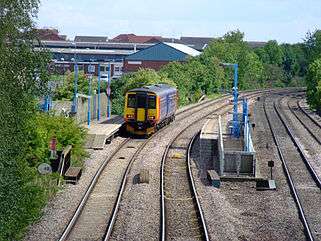Ivanhoe Line
| Ivanhoe Line | |
|---|---|
|
A Class 156 Sprinter running on the line | |
| Overview | |
| Type | Heavy rail |
| System | National Rail |
| Status | Operational |
| Locale | East Midlands |
| Termini |
Loughborough Burton upon Trent |
| Stations | 6 |
| Operation | |
| Opened | 1993 |
| Owner | Network Rail |
| Operator(s) | East Midlands Trains |
| Rolling stock |
Class 153 "Super Sprinter" Class 156 "Super Sprinter" Class 158 "Express Sprinter" |
| Technical | |
| Number of tracks | 2–4 |
| Track gauge | 4 ft 8 1⁄2 in (1,435 mm) standard gauge |
| Operating speed | less than 75mph |
| Ivanhoe Line | |
|---|---|
Legend
|
The Ivanhoe Line was the name given to local passenger services operated on the Midland Main Line between Leicester and Loughborough between 1993, when three intermediate stations were re-opened, and June 2005, when the separate Leicester–Loughborough service was withdrawn. Intermediate stations on the route are now served by East Midlands Trains' hourly service between Leicester, Nottingham and Lincoln.
History
After phase one of the Ivanhoe Line was completed in the mid 1990s it was originally planned that phase two would extend the line west to Burton-on-Trent on the current freight-only line via Coalville and Ashby-de-la-Zouch. In 2006 the Conservative Party released a brief of its plans for reopening the line.
A report published in December 2008[1] assumed that the total number of passenger journeys would be 150,000 per annum, each paying an average of £3.15 per journey. It also assumed that no-one would use the line at week-ends, even though it runs via the successful tourist attractions of the National Forest. This equates to an assumption that just over 300 return journeys would be made daily, and only during the week. However, according to the latest travel to work plans, there are some 4,000-6,000 car journeys daily on the Coalville to Leicester corridor, and 6,000-8,000 per day from the south. Thus about 12,000 car journeys takes place along part or all of the route. It is not considered credible that only 2.5% would be attracted on to the train, so there is therefore a widespread belief that the report's economic assumptions were wrong.
In June 2009 the Association of Train Operating Companies recommended reopening of the line to passenger services with stations at Kirby Muxloe, Bagworth, Coalville, Ashby-de-la-Zouch, Moira and Gresley.[2] ATOC estimated that the capital cost at £49 million, the benefit-cost ratio (BCR) to be 1.3 and the BCR excluding capital costs to be 2.9.[3] Leicestershire County Council again ruled out the proposal, claiming it would cost a £4 million annual subsidy. However, previous reports had suggested the subsidy required would be far less, and that after the initial investment the line would make money.[4]
Today
One station on the Derby - Birmingham main line, Willington, past the western (Burton) end of the route, was constructed in the mid 1990s with Ivanhoe branding and painted in the according blue livery. However, as a result of the failure of the Burton upon Trent - Leicester development to go ahead, it is a curious anomaly, separated from the Ivanhoe Line scheme.
A similar anomaly lies at the eastern (Leicester) end of the line, along the Leicester-Loughborough main line, where three stations were reopened as a planned first phase of full reopening:
Local passenger services on the route are currently operated by diesel multiple units of Classes 153, 156 or 158.
Trains use the slow lines from just north of Leicester to Loughborough, previously used almost exclusively for freight, so as well as the rebuilding of the three intermediate stations, work was also required to build a new third platform at Loughborough facing the Down Slow, and also a new crossover and signal south of Loughborough so southbound trains could cross from the Down Slow to the Up Slow.
Barrow and Sileby each have two platforms (with limited access for disabled passengers), but Syston has a single platform serving both directions. Syston station will be rebuilt around 2013 during a Leicester area re-signalling scheme[5] as part of Network Rails Route Utilisation Strategy for freight.[6]
Future
The intermediate stations are capable of taking only a two-coach train, which has led to overcrowding on some services, especially now that the service is extended to Nottingham and Lincoln. The latest Route Utilisation Strategy for the East Midlands makes recommendations for platform lengthening.
East Midlands Parkway railway station has now been built on the route. The Borough of Charnwood's local plan anticipates a station at Thurmaston.[7]
References
| Wikimedia Commons has media related to Ivanhoe Line. |
- ↑ "A blow to Ivanhoe hopes". Leicester Mercury. 2008-12-03.
- ↑ Connecting Communities; Expanding Access to the Rail Network. London: Association of Train Operating Companies. 2009. p. 19.
- ↑ ATOC, op. cit., 2009, page 16
- ↑ "Re-opening rail line 'too costly'". Leicester Mercury. 2009-09-09.
- ↑ "East Midlands". Network Rail. Retrieved 2008-08-29.
- ↑ "Route Utilisation Strategy > Freight".
- ↑ adopted_plan_for_charnwood_-_chapter_7

